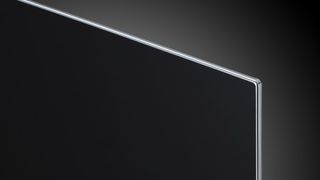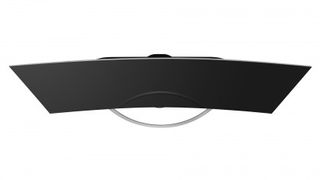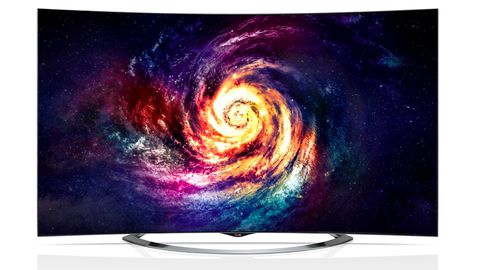Why you can trust TechRadar
For the most part the 65EC970V delivers emphatically on its OLED-based picture quality promise.
Its contrast performance in particular is just incredible.
The deepest, richest black colours I've simply ever seen on a television work wonders on anything you watch - but especially films, with their relatively extreme contrast ranges. The blackness makes pictures look more natural and more colour-rich, and OLED's ability to combine almost complete blackness in one pixel with bright whites and colours in neighbouring pixels means that pictures look gorgeously and expressively dynamic.

The 65EC970V's OLED screen is particularly effective at showing small areas of light against predominantly dark backdrops. For instance, if a clip features lights showing in the windows of a building at night there is simply no other TV technology that can deliver such vibrancy and colour richness for the light parts while simultaneously providing such unprecedentedly deep black parts.
With all LCD screens both the light and dark elements of such images are compromised, with the light parts looking a little flat and lifeless, and the dark parts looking a little greyed over.
The degree of these compromises naturally varies from LCD screen to LCD screen, but to reiterate this point, no LCD screen can even get close to the localised contrast performance the 65EC970V can deliver.
Which is exactly why home cinema fans love OLED so much.
Natural beauty
We nearly always find that a TV's colour performance is directly related to its ability to produce a good black colour. So it's no great shock to find the 65EC970V delivering for the most part a lovely colour performance that combines rich, vibrant tones with a reasonably wide colour range and tones which are generally winningly natural.
There's never a feeling of cartoonishness about the 65EC970V's video pictures, despite their vibrancy.
Native UHD content lives up to our hopes too. The image structure issues noted with the 55EC930V completely disappear, leaving you looking at gloriously polished, detailed pictures that look pretty much like real life for the majority of the time, in just the sort of way good UHD pictures should.
There's no longer so much as a hint of the individual pixels being used to create pictures.

It helps the sense of clarity delivered with UHD sources that the 65EC970V is a reasonable handler of motion, suffering less with the motion blur problems than LCD TVs tend to.
It's a pity that LG's motion processing isn't particularly great, causing obvious unwanted side effects if you use it. But the main point is that you don't really need to use it.
The combination of all the 65EC970V's strengths - especially the contrast - delivers pictures that look at times genuinely better than anything I've ever seen before. But that is not the same thing as saying they're perfect.
There are problems to report too.
Carefully does it...
First, and most surprising, it's possible to mess up the 65EC970V's black level performance. Leave the TV's brightness too low - as LG's own picture presets do, actually - and noticeable amounts of shadow detail can disappear into the blackness.
Shift the brightness too high, though, and bizarrely dark areas start to be infused first with a yellowish hue and then, if you keep pushing them, a grey wash all too reminiscent of the look of a low-quality LCD TV.
At the yellowish stage, moreover, you can see what appear to be different levels of brightness across the screen, with the edges looking darker than the central areas.
None of these issues make sense given our understanding of OLED's self-emissive nature, but that doesn't change the fact that they're there.

The good news is that it's just possible to achieve a balance between the TV's brightness, contrast and 'OLED brightness' settings that really does combine gorgeous LCD-battering black levels with plenty of shadow detail and no obvious luminance inconsistencies.
You may have to tweak the settings from time to time to suit different types of source material, but for the most part I'd recommend using a brightness value of between 50 and 55, a contrast setting of around 88-90, and an OLED brightness setting of around 90.
It should be stressed, actually, that a well-balanced 65EC970V delivers a fairly amazing amount of shadow detail during dark scenes. Certainly if you find yourself watching any scenes in space you'll see many, many more stars in the sky than you'll ever have seen on any LCD TV.
Turning to the 65EC970V's colours, while for much of the time they're excellent I did sometimes see unwanted pink or green tints sneak into parts of (usually quite dark) pictures.
There's also a tendency for certain dark but heavily textured picture areas to take on a bluish tinge, and it struck me too that the 65EC970V doesn't deliver subtle colour blends and shifts as effectively as the best of its rivals. This can cause some gentle colour striping at times, and occasionally gives skin tones a rather patchy look.
It's also a simple fact that the 65EC970V's colours don't rival the intensity of those experienced with native HDR content viewed on Samsung's JS9500 LCD TVs.
And, having mentioned those sets, it's also important to point out that they're capable of producing much brighter pictures than this OLED too.
A bigger concern given the current paucity of native UHD 4K content is that the 65EC970V's upscaling of HD isn't as good as that of some rivals. Noise is kept reasonably well suppressed, but there's a softer, less detailed look to upscaled HD than you see with the best UHD TVs from Samsung, Sony and Panasonic.
It's perhaps not surprising from this that the 65EC970V isn't especially easy on the eye with standard definition either - though the LG set is hardly alone in this regard.

Curvaceous
As promised earlier, we should add a couple of points about the 65EC970V's curved screen from a picture quality perspective.
If you sit so close to the screen that it pretty much fills your field of view you may feel slightly more immersed in the action thanks to the way the image wraps around into your peripheral vision. But the curve can distort reflections if you've got a bright light source opposite the screen, as well as damaging image geometry if you have to watch from much an angle down the TV's side.
However, since we really ought to finish on the sort of positive note the 65EC970V's pictures so richly deserve overall, while the curve may limit viewing angles, pictures suffer none of the drop off in colour and contrast you see with LCD TVs if you have to watch them from an angle.
The 65EC970V is also a mesmerisingly good 3D performer.
We know most of you have apparently given up on 3D these days, but if you give the 65EC970V a chance it will surely reawaken your interest thanks to its gorgeously crisp, clean, colourful, bright, crosstalk-free, flicker-free and natural 3D images.
If only 3D on a TV had been this good from the start it's hard to imagine the format would have suffered such a sorry decline in interest.
Current page: Picture Quality
Prev Page Introduction and features Next Page Usability, Sound and ValueJohn has been writing about home entertainment technology for more than two decades - an especially impressive feat considering he still claims to only be 35 years old (yeah, right). In that time he’s reviewed hundreds if not thousands of TVs, projectors and speakers, and spent frankly far too long sitting by himself in a dark room.


